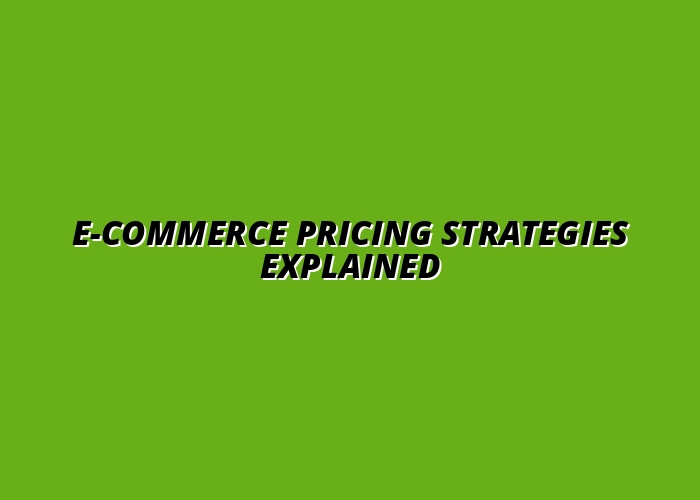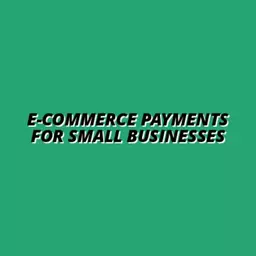E-Commerce Pricing Strategies Explained

Posted on: 2025-08-09
By: Liam Corbin
The landscape of e-commerce is ever-evolving, and one of the most crucial aspects that can make or break a business is its pricing strategy. Did you know that a well-set price can significantly impact your profit margins and customer loyalty? By understanding and implementing effective pricing strategies, you can position your brand for success in a competitive market.
What You Will Learn
- Effective pricing strategies can directly maximize revenue by aligning prices with consumer perceptions.
- Competitive pricing plays a crucial role in market positioning, making it essential to regularly analyze competitor prices.
- Real-world case studies showcase the impact of innovative pricing strategies, such as dynamic pricing and value-based pricing, on sales and customer loyalty.
- Continuous learning and adaptation in pricing approaches are key to staying relevant and profitable in the fast-paced e-commerce environment.
- Sales forecasting enhances pricing strategies by identifying seasonal trends and aligning marketing efforts for maximum impact.
Key Insights on E-Commerce Pricing Strategies
The following highlights the significant impacts of various pricing strategies implemented by e-commerce businesses.
Retailer A
Implemented value-based pricing, leading to a 30% increase in overall sales.
Retailer B
Adopted a bundling strategy, resulting in a significant boost in average order value.
Retailer C
Used competitive pricing analysis to enhance customer retention rates in a crowded marketplace.
Impact Summary
These strategies showcase how tailored pricing can effectively drive sales and strengthen market position.
Understanding E-Commerce Pricing Strategies for Profit Optimization
When diving into the world of e-commerce, one of the most crucial elements to consider is pricing. It’s not just about putting a number on your products; effective pricing strategies can significantly boost your profitability and set you apart from the competition. At The Cash Automator, I’ve seen firsthand how the right pricing approach can transform a struggling shop into a flourishing business.
Why does pricing matter? It's the first thing customers notice when browsing your store. A well-thought-out pricing strategy not only attracts buyers but also establishes your brand's value. By understanding the intricacies of pricing, you can connect better with your audience and enhance your overall market presence.
Identifying the Importance of Pricing in E-Commerce
Let’s break down why pricing strategies are so vital for your e-commerce success. First off, effective pricing directly impacts your profit margins. Think about it—setting the right price can mean the difference between profit and loss in your online venture. For more on maximizing your profits, consider implementing automated e-commerce sales systems.
Moreover, pricing plays a vital role in your position within the competitive landscape. If your prices are too high, you might scare off potential customers. Conversely, if they're too low, you risk undervaluing your products. It’s all about finding that sweet spot that resonates with your target audience.
Why Effective Pricing Strategies Matter for Profitability
Effective pricing strategies can optimize your profitability in several ways:
- Maximizes revenue by aligning prices with consumer perceptions.
- Enhances overall sales volume through competitive pricing.
- Improves customer loyalty by creating a sense of value.
By focusing on these aspects, you’ll not only attract more customers but also keep them coming back. Trust me, as someone who's navigated the ups and downs of e-commerce, a solid pricing strategy is essential!
The Role of Pricing in Competitive Market Positioning
Pricing is a powerful tool in shaping your market positioning. It tells your customers who you are as a brand. Are you a budget-friendly option or a luxury brand? Your pricing can convey that message effectively. Think of it as a reflection of your brand identity.
To maintain a competitive edge, consider these tactics:
- Regularly analyze competitor prices to adjust your strategy.
- Test different pricing models to see which resonates best with your audience.
- Utilize customer feedback to refine your pricing approach.
When you take these steps, you’ll position your e-commerce business to thrive, even in the most saturated markets. Pricing isn’t just a number; it’s a key to unlocking your business's potential!
Quick Summary
Here's a brief recap of the key points discussed so far:
- Effective pricing strategies significantly influence profitability and market positioning.
- Understanding competitor pricing helps maintain relevance and attract customers.
- Real-world case studies illustrate successful pricing implementations and their impacts on sales.
Real-World Applications and Case Studies of E-Commerce Pricing Strategies
When it comes to understanding the impact of pricing strategies in e-commerce, *real-world applications* can provide incredible insights. Case studies offer tangible examples of how effective pricing can lead to increased sales and customer loyalty. By looking at actual businesses that have successfully implemented these strategies, we can see the difference that informed pricing decisions can make. So, let’s dive into some inspiring success stories!
One standout example is a well-known online retailer that revamped its pricing strategy by incorporating dynamic pricing. They utilized sophisticated software to adjust prices based on demand and competitor pricing. The result? A remarkable boost in sales and a noticeable increase in customer engagement! This is a clear testament to the power of adapting pricing in real-time to meet market needs. To learn more about optimizing your e-commerce operations, explore tracking e-commerce analytics simply.
Success Stories: Case Studies on Implemented Pricing Strategies
Throughout my journey with *The Cash Automator*, I’ve seen how various e-commerce businesses have thrived by adopting innovative pricing strategies. Here are a few noteworthy case studies:
- Retailer A: Implemented value-based pricing, leading to a 30% increase in overall sales.
- Retailer B: Adopted a bundling strategy, resulting in a significant boost in average order value.
- Retailer C: Used competitive pricing analysis to position themselves effectively in a crowded marketplace, enhancing customer retention rates.
These examples highlight the variety of approaches businesses can take to optimize their pricing. By learning from these *success stories*, we can better appreciate the importance of effective pricing strategies in driving profitability.
Analyzing ROI from Effective Pricing Models
Understanding your return on investment (ROI) from pricing strategies is crucial for e-commerce success. Analyzing the financial impact of these models can be done through several key steps:
- Identify the baseline sales before implementing a new pricing strategy.
- Measure the change in sales volume after the strategy has been applied.
- Calculate overall profit margins to see if the new pricing has positively impacted profitability.
This analysis not only helps in evaluating the effectiveness of the pricing model but also guides future decisions. As I often advise my community at *The Cash Automator*, tracking these metrics can provide valuable insights that inform adjustments for ongoing success!
Exploring the Role of Competitive Pricing in Market Success
Competitive pricing plays a vital role in ensuring that your e-commerce business remains relevant in the marketplace. By keeping an eye on what competitors are doing, you can adjust your pricing strategy accordingly. Here’s why it matters:
- Maintaining market relevance by aligning with competitor prices.
- Attracting price-sensitive customers to boost sales.
- Building brand loyalty through perceived value for money.
Ultimately, the key to successful pricing lies in understanding your unique market position and leveraging that knowledge for maximum profitability! By implementing these insights, you’ll find yourself on the path to better pricing strategies that resonate with your audience.
Frequently Asked Questions About E-commerce Pricing Strategies
Engagement and Interactive Elements for Practical Application
To truly engage your audience and enhance their experience, consider incorporating interactive elements into your pricing strategy discussions. This not only empowers users but also allows them to apply what they’ve learned. Here are some effective engagement tools to consider:
- Interactive pricing calculators that allow users to see how different pricing models impact their profits.
- Strategy checklists that guide e-commerce businesses through the implementation of pricing strategies.
- Price comparison tools that provide users with insights into how their prices stack up against competitors.
By providing these interactive elements, you encourage active participation and foster a deeper understanding of pricing strategies. This aligns perfectly with the mission of *The Cash Automator* to empower individuals to build successful online income streams through knowledge and practical tools.
Providing Interactive Pricing Calculators for User Engagement
Interactive pricing calculators can transform a user’s learning experience into a hands-on exercise. When users actively engage with pricing tools, they’re more likely to retain information and apply strategies effectively. Here’s how you could structure such calculators:
- Input fields for costs, desired profit margins, and competitor prices.
- Dynamic output showing potential profits based on different pricing strategies.
- Recommendations based on user inputs to suggest optimal pricing strategies.
This approach not only educates users but also empowers them to make informed pricing decisions in their e-commerce endeavors!
Summarizing Key Takeaways for E-Commerce Pricing Effectiveness
As we wrap up our discussion on pricing strategies, it’s essential to highlight the key takeaways for ensuring *e-commerce pricing effectiveness*. Here’s a concise recap of the steps you can implement:
- Conduct thorough cost analysis to understand your pricing baseline.
- Choose the right pricing model that aligns with your business goals.
- Utilize data-driven insights to monitor and refine your strategies.
By focusing on these steps and continuously adapting your approach, you can create a pricing strategy that not only drives sales but also enhances customer satisfaction. Remember, learning is an ongoing process, and making adjustments based on real-world feedback is key to staying ahead!
Encouraging Continuous Learning and Adaptation in Pricing Approaches
In the fast-paced world of e-commerce, the ability to learn and adapt is essential. Encourage your team and yourself to stay updated on trends and best practices in pricing strategies. Here are some methods to foster continuous learning:
- Attend webinars and workshops focused on e-commerce and pricing strategies.
- Engage in community discussions where experiences and strategies can be shared.
- Read industry-related articles and case studies to gain new insights.
By nurturing a culture of learning, you’ll empower yourself and your business to thrive in an ever-changing market landscape! For further insights into e-commerce growth, consider exploring strategies for boosting e-commerce customer loyalty.
Highlighting the Importance of Sales Forecasting in Pricing Strategy
Sales forecasting is a critical component of any effective pricing strategy. With accurate forecasts, you can make informed decisions that directly impact your profitability. Key benefits of sales forecasting include:
- Identifying seasonal trends to adjust pricing accordingly.
- Calculating anticipated revenue to guide inventory management.
- Aligning marketing efforts with pricing strategies for maximum impact.
By integrating sales forecasting into your pricing strategy, you’ll enhance your ability to navigate market challenges and seize opportunities. Let’s make our e-commerce journeys successful and profitable! To further enhance your e-commerce success, consider implementing simple e-commerce SEO strategies.
Call to Action: Start Implementing Effective E-Commerce Pricing Strategies Today
Now that we've explored these valuable insights on e-commerce pricing strategies, it's time to take action! I encourage you to reflect on your own pricing strategies and share your experiences with the community. What challenges have you faced, and what successes have you achieved? Your stories can inspire others on their journey!
Additionally, I invite you to participate in discussions within the e-commerce community. By sharing knowledge and insights, we can all learn and grow together. Remember, *The Cash Automator* is here to support you every step of the way as you implement effective pricing strategies for your e-commerce ventures. Let’s get started! For more resources, visit The Cash Automator's e-commerce tips.
Recap of Key Points
Here is a quick recap of the important points discussed in the article:
- Effective pricing directly impacts profitability and can differentiate your brand in the competitive landscape.
- Utilize competitive pricing analysis to adapt your strategies and enhance customer loyalty.
- Implement real-world case studies to learn from successful e-commerce pricing strategies.
- Regularly analyze your pricing model's ROI to make informed adjustments for ongoing success.
- Incorporate interactive tools, like pricing calculators, to engage users and improve understanding of pricing strategies.
- Foster a culture of continuous learning to stay updated on trends and refine your pricing approaches.
- Utilize sales forecasting to anticipate market demands and strategize effectively.
 Creating a membership site can be your gateway to generating income effortlessly, allowing you to ea
Creating a membership site can be your gateway to generating income effortlessly, allowing you to ea
 As the e-commerce landscape evolves, small businesses must adapt to stay competitive. Did you know t
As the e-commerce landscape evolves, small businesses must adapt to stay competitive. Did you know t
 When it comes to affiliate marketing, leveraging the power of webinars can transform your approach.
When it comes to affiliate marketing, leveraging the power of webinars can transform your approach.